Sustainability of Visitor Transport Services at Christchurch Airport
VerifiedAdded on 2023/03/30
|26
|3730
|345
Report
AI Summary
This report provides a secondary research analysis of the sustainability of visitor transport services at Christchurch International Airport in New Zealand. It reviews New Zealand's tourism sustainability commitments, focusing on economic, visitor, host community, and environmental aspects. The report evaluates the airport's sustainable practices, highlighting strengths and weaknesses in areas like productivity, visitor engagement, quality employment, carbon reduction, and education. It identifies gaps between theoretical commitments and actual practices, offering recommendations for improvement and alignment with sustainability goals. The study emphasizes the integration of sustainable measures to enhance the visitor experience and contribute to New Zealand's broader tourism sustainability objectives.
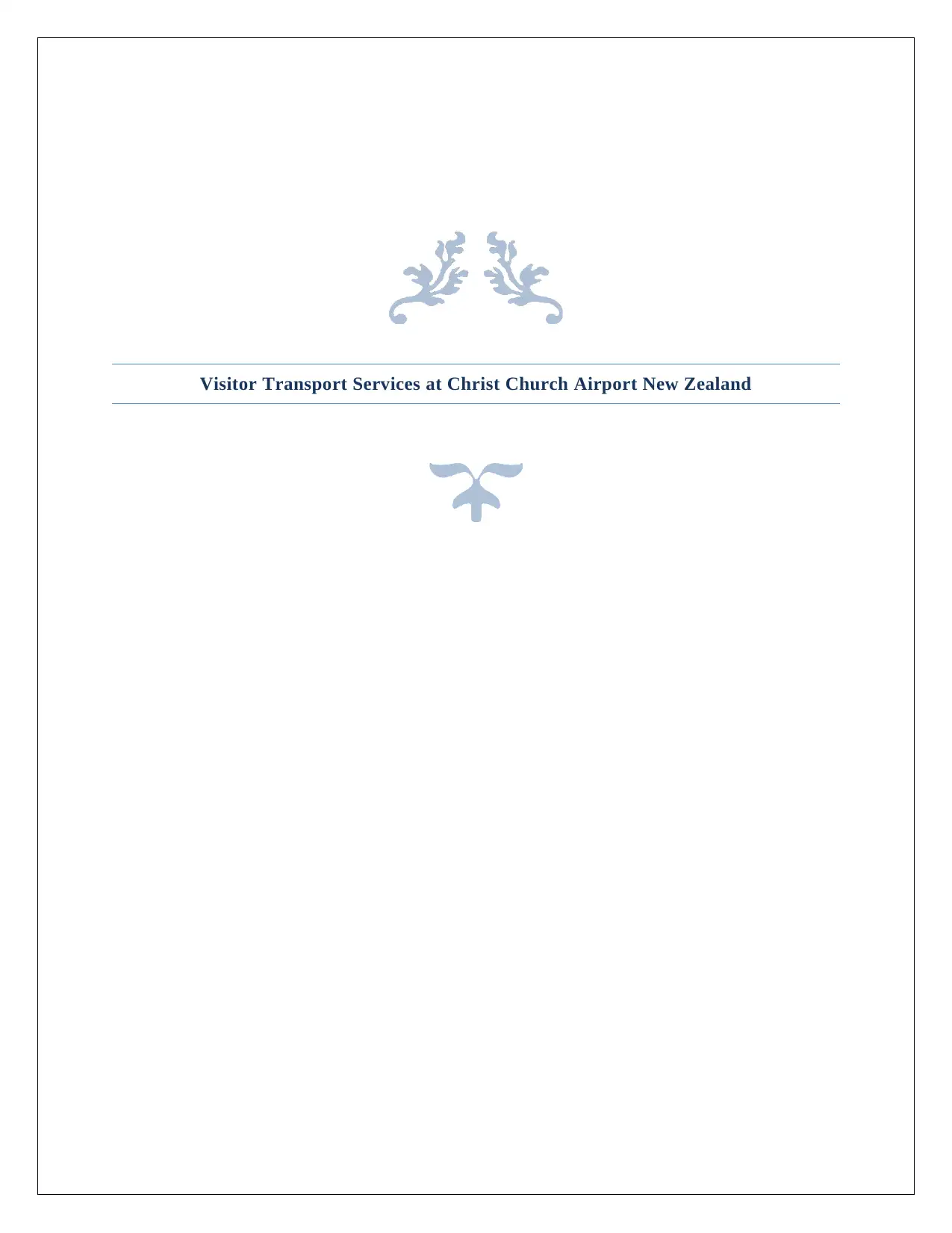
Visitor Transport Services at Christ Church Airport New Zealand
Paraphrase This Document
Need a fresh take? Get an instant paraphrase of this document with our AI Paraphraser
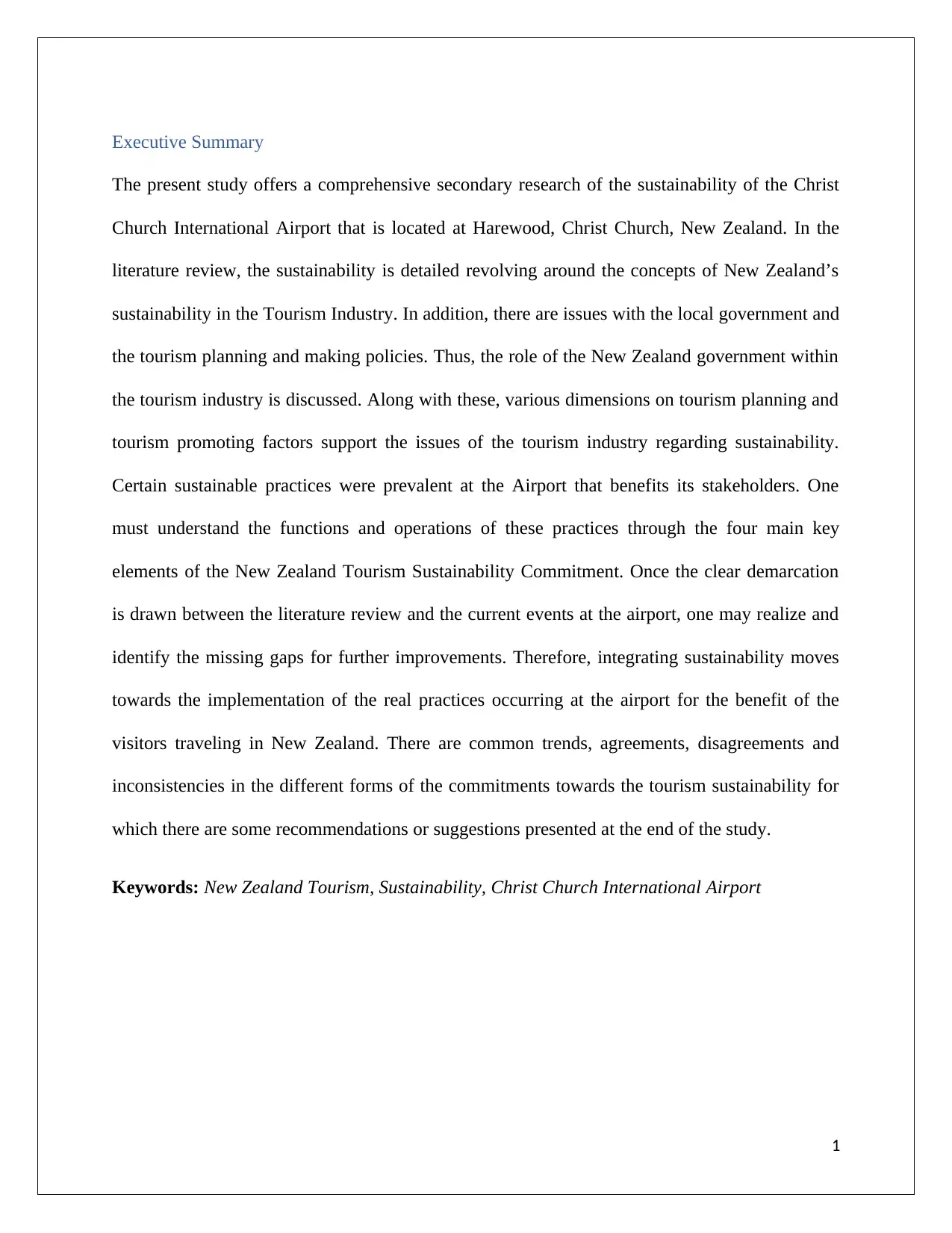
Executive Summary
The present study offers a comprehensive secondary research of the sustainability of the Christ
Church International Airport that is located at Harewood, Christ Church, New Zealand. In the
literature review, the sustainability is detailed revolving around the concepts of New Zealand’s
sustainability in the Tourism Industry. In addition, there are issues with the local government and
the tourism planning and making policies. Thus, the role of the New Zealand government within
the tourism industry is discussed. Along with these, various dimensions on tourism planning and
tourism promoting factors support the issues of the tourism industry regarding sustainability.
Certain sustainable practices were prevalent at the Airport that benefits its stakeholders. One
must understand the functions and operations of these practices through the four main key
elements of the New Zealand Tourism Sustainability Commitment. Once the clear demarcation
is drawn between the literature review and the current events at the airport, one may realize and
identify the missing gaps for further improvements. Therefore, integrating sustainability moves
towards the implementation of the real practices occurring at the airport for the benefit of the
visitors traveling in New Zealand. There are common trends, agreements, disagreements and
inconsistencies in the different forms of the commitments towards the tourism sustainability for
which there are some recommendations or suggestions presented at the end of the study.
Keywords: New Zealand Tourism, Sustainability, Christ Church International Airport
1
The present study offers a comprehensive secondary research of the sustainability of the Christ
Church International Airport that is located at Harewood, Christ Church, New Zealand. In the
literature review, the sustainability is detailed revolving around the concepts of New Zealand’s
sustainability in the Tourism Industry. In addition, there are issues with the local government and
the tourism planning and making policies. Thus, the role of the New Zealand government within
the tourism industry is discussed. Along with these, various dimensions on tourism planning and
tourism promoting factors support the issues of the tourism industry regarding sustainability.
Certain sustainable practices were prevalent at the Airport that benefits its stakeholders. One
must understand the functions and operations of these practices through the four main key
elements of the New Zealand Tourism Sustainability Commitment. Once the clear demarcation
is drawn between the literature review and the current events at the airport, one may realize and
identify the missing gaps for further improvements. Therefore, integrating sustainability moves
towards the implementation of the real practices occurring at the airport for the benefit of the
visitors traveling in New Zealand. There are common trends, agreements, disagreements and
inconsistencies in the different forms of the commitments towards the tourism sustainability for
which there are some recommendations or suggestions presented at the end of the study.
Keywords: New Zealand Tourism, Sustainability, Christ Church International Airport
1
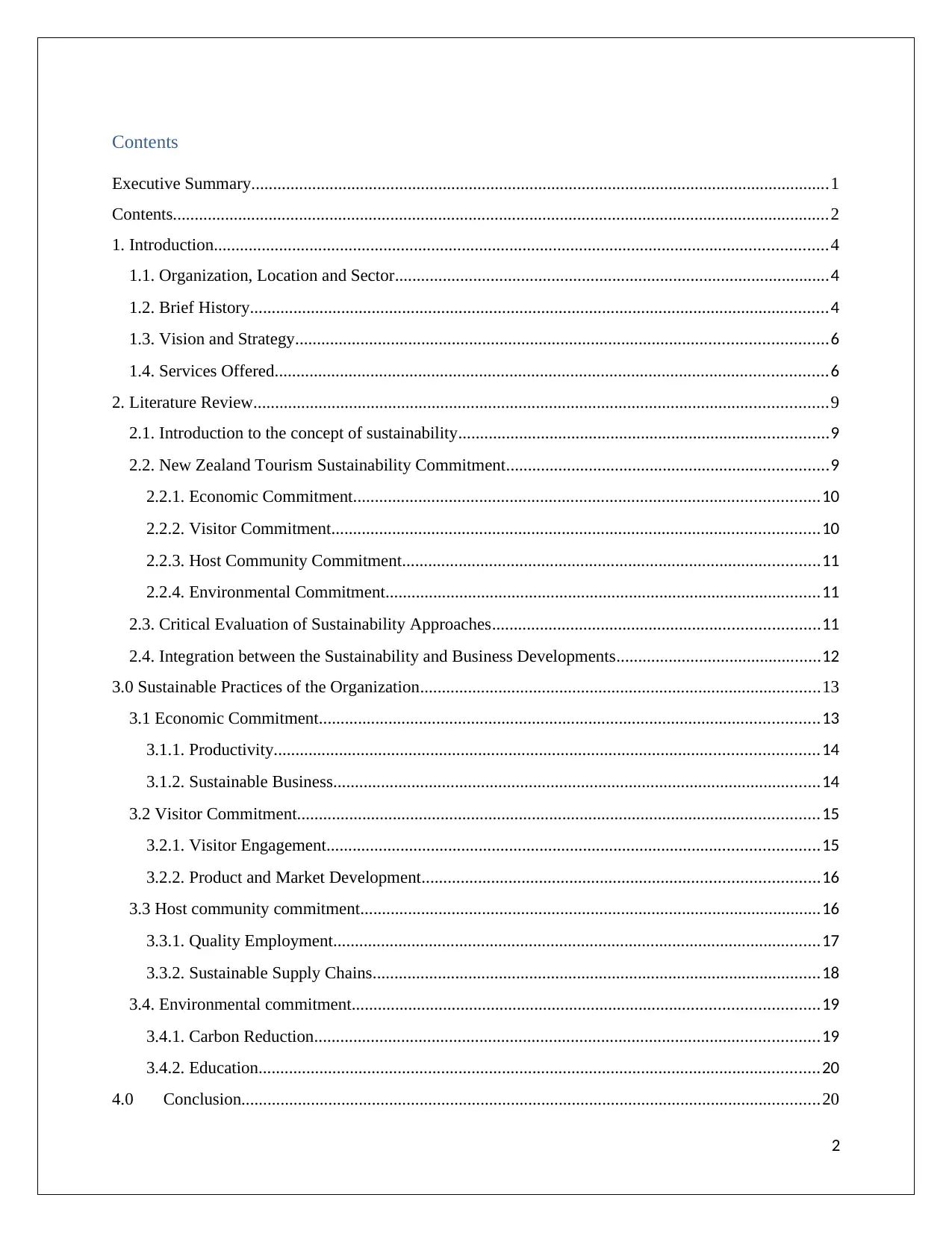
Contents
Executive Summary.....................................................................................................................................1
Contents.......................................................................................................................................................2
1. Introduction.............................................................................................................................................4
1.1. Organization, Location and Sector....................................................................................................4
1.2. Brief History.....................................................................................................................................4
1.3. Vision and Strategy..........................................................................................................................6
1.4. Services Offered...............................................................................................................................6
2. Literature Review....................................................................................................................................9
2.1. Introduction to the concept of sustainability.....................................................................................9
2.2. New Zealand Tourism Sustainability Commitment..........................................................................9
2.2.1. Economic Commitment...........................................................................................................10
2.2.2. Visitor Commitment................................................................................................................10
2.2.3. Host Community Commitment................................................................................................11
2.2.4. Environmental Commitment....................................................................................................11
2.3. Critical Evaluation of Sustainability Approaches...........................................................................11
2.4. Integration between the Sustainability and Business Developments...............................................12
3.0 Sustainable Practices of the Organization............................................................................................13
3.1 Economic Commitment...................................................................................................................13
3.1.1. Productivity.............................................................................................................................14
3.1.2. Sustainable Business................................................................................................................14
3.2 Visitor Commitment........................................................................................................................15
3.2.1. Visitor Engagement.................................................................................................................15
3.2.2. Product and Market Development...........................................................................................16
3.3 Host community commitment..........................................................................................................16
3.3.1. Quality Employment................................................................................................................17
3.3.2. Sustainable Supply Chains.......................................................................................................18
3.4. Environmental commitment...........................................................................................................19
3.4.1. Carbon Reduction....................................................................................................................19
3.4.2. Education.................................................................................................................................20
4.0 Conclusion.....................................................................................................................................20
2
Executive Summary.....................................................................................................................................1
Contents.......................................................................................................................................................2
1. Introduction.............................................................................................................................................4
1.1. Organization, Location and Sector....................................................................................................4
1.2. Brief History.....................................................................................................................................4
1.3. Vision and Strategy..........................................................................................................................6
1.4. Services Offered...............................................................................................................................6
2. Literature Review....................................................................................................................................9
2.1. Introduction to the concept of sustainability.....................................................................................9
2.2. New Zealand Tourism Sustainability Commitment..........................................................................9
2.2.1. Economic Commitment...........................................................................................................10
2.2.2. Visitor Commitment................................................................................................................10
2.2.3. Host Community Commitment................................................................................................11
2.2.4. Environmental Commitment....................................................................................................11
2.3. Critical Evaluation of Sustainability Approaches...........................................................................11
2.4. Integration between the Sustainability and Business Developments...............................................12
3.0 Sustainable Practices of the Organization............................................................................................13
3.1 Economic Commitment...................................................................................................................13
3.1.1. Productivity.............................................................................................................................14
3.1.2. Sustainable Business................................................................................................................14
3.2 Visitor Commitment........................................................................................................................15
3.2.1. Visitor Engagement.................................................................................................................15
3.2.2. Product and Market Development...........................................................................................16
3.3 Host community commitment..........................................................................................................16
3.3.1. Quality Employment................................................................................................................17
3.3.2. Sustainable Supply Chains.......................................................................................................18
3.4. Environmental commitment...........................................................................................................19
3.4.1. Carbon Reduction....................................................................................................................19
3.4.2. Education.................................................................................................................................20
4.0 Conclusion.....................................................................................................................................20
2
⊘ This is a preview!⊘
Do you want full access?
Subscribe today to unlock all pages.

Trusted by 1+ million students worldwide

5.0 Recommendations..........................................................................................................................22
6.0 References.....................................................................................................................................23
3
6.0 References.....................................................................................................................................23
3
Paraphrase This Document
Need a fresh take? Get an instant paraphrase of this document with our AI Paraphraser
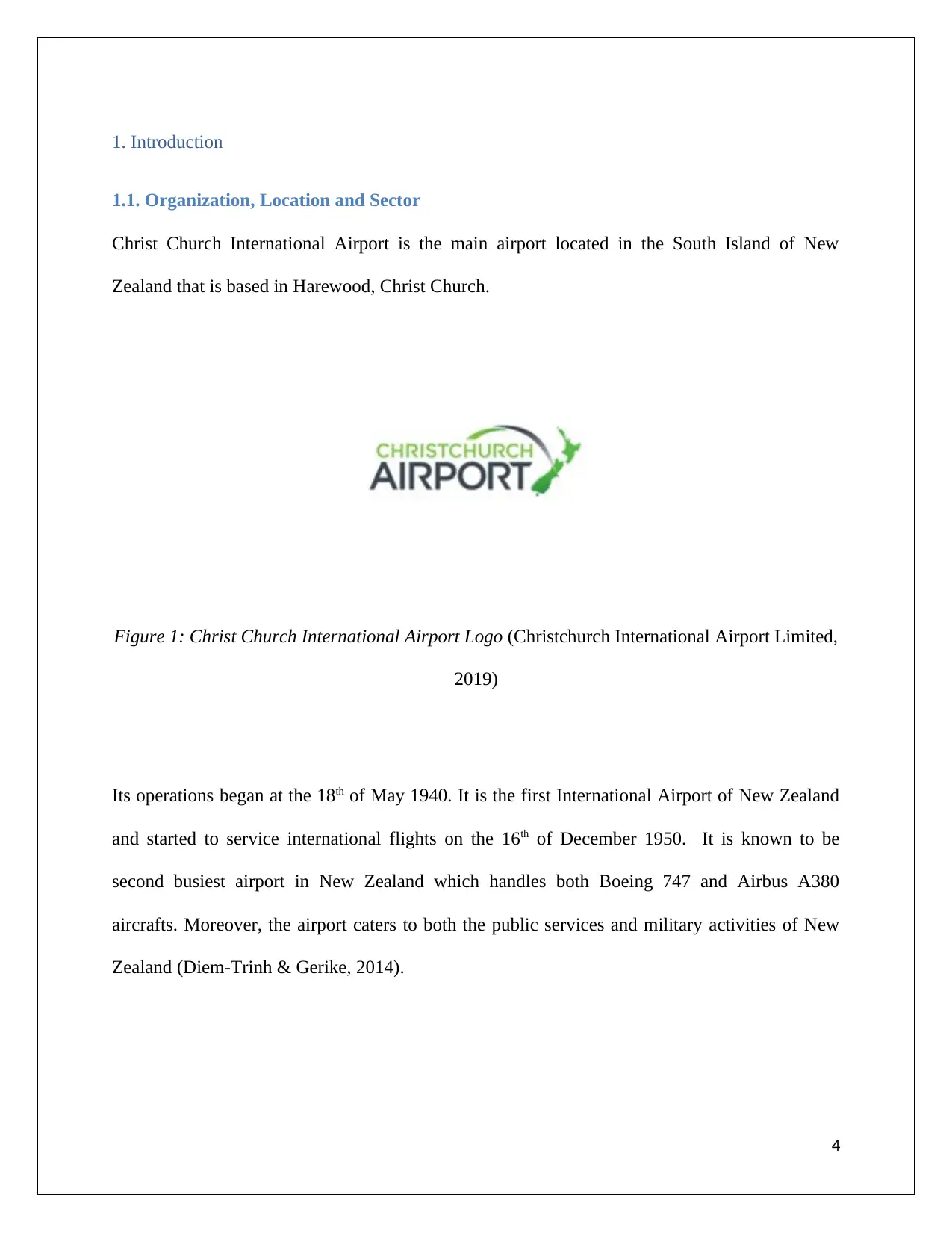
1. Introduction
1.1. Organization, Location and Sector
Christ Church International Airport is the main airport located in the South Island of New
Zealand that is based in Harewood, Christ Church.
Figure 1: Christ Church International Airport Logo (Christchurch International Airport Limited,
2019)
Its operations began at the 18th of May 1940. It is the first International Airport of New Zealand
and started to service international flights on the 16th of December 1950. It is known to be
second busiest airport in New Zealand which handles both Boeing 747 and Airbus A380
aircrafts. Moreover, the airport caters to both the public services and military activities of New
Zealand (Diem-Trinh & Gerike, 2014).
4
1.1. Organization, Location and Sector
Christ Church International Airport is the main airport located in the South Island of New
Zealand that is based in Harewood, Christ Church.
Figure 1: Christ Church International Airport Logo (Christchurch International Airport Limited,
2019)
Its operations began at the 18th of May 1940. It is the first International Airport of New Zealand
and started to service international flights on the 16th of December 1950. It is known to be
second busiest airport in New Zealand which handles both Boeing 747 and Airbus A380
aircrafts. Moreover, the airport caters to both the public services and military activities of New
Zealand (Diem-Trinh & Gerike, 2014).
4
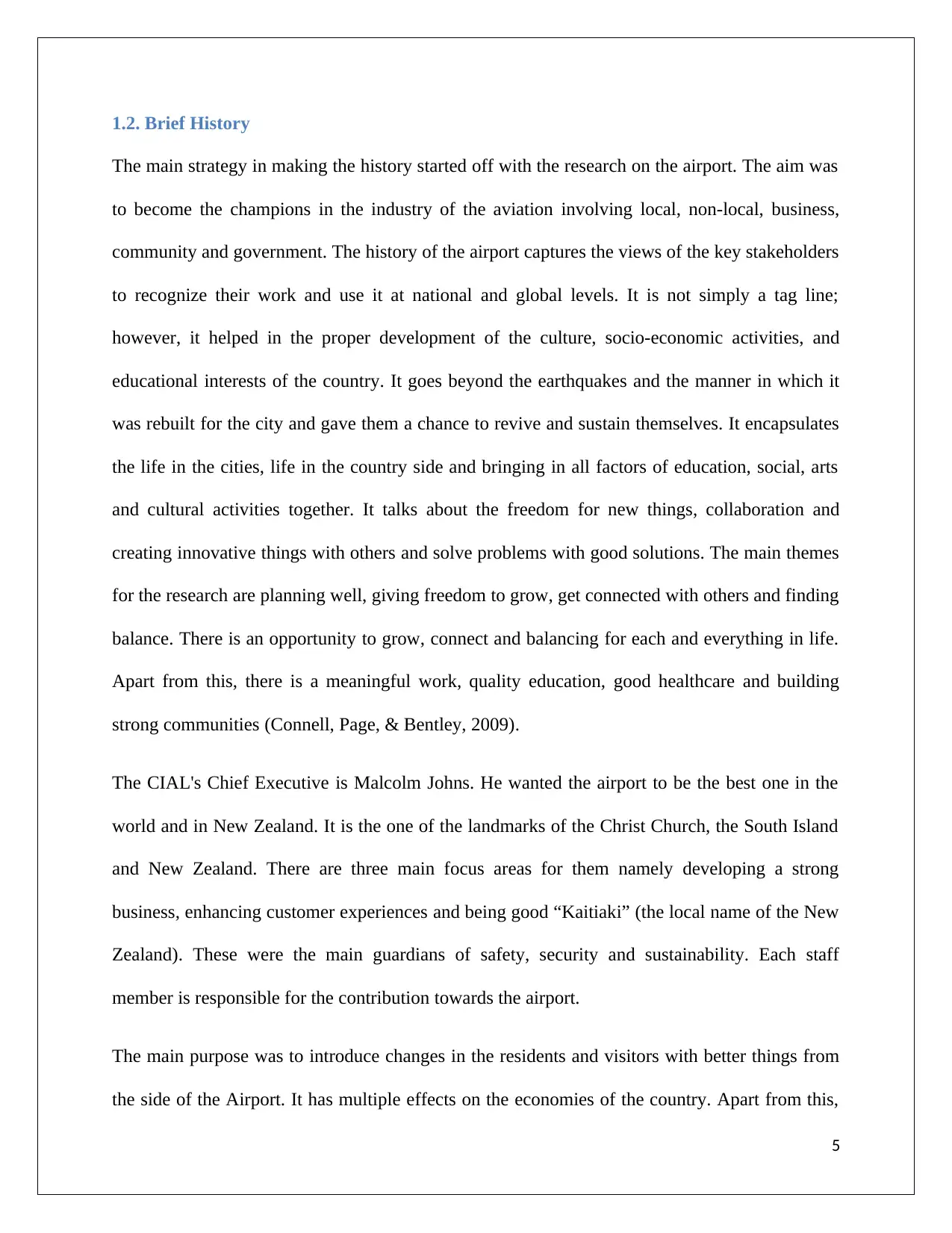
1.2. Brief History
The main strategy in making the history started off with the research on the airport. The aim was
to become the champions in the industry of the aviation involving local, non-local, business,
community and government. The history of the airport captures the views of the key stakeholders
to recognize their work and use it at national and global levels. It is not simply a tag line;
however, it helped in the proper development of the culture, socio-economic activities, and
educational interests of the country. It goes beyond the earthquakes and the manner in which it
was rebuilt for the city and gave them a chance to revive and sustain themselves. It encapsulates
the life in the cities, life in the country side and bringing in all factors of education, social, arts
and cultural activities together. It talks about the freedom for new things, collaboration and
creating innovative things with others and solve problems with good solutions. The main themes
for the research are planning well, giving freedom to grow, get connected with others and finding
balance. There is an opportunity to grow, connect and balancing for each and everything in life.
Apart from this, there is a meaningful work, quality education, good healthcare and building
strong communities (Connell, Page, & Bentley, 2009).
The CIAL's Chief Executive is Malcolm Johns. He wanted the airport to be the best one in the
world and in New Zealand. It is the one of the landmarks of the Christ Church, the South Island
and New Zealand. There are three main focus areas for them namely developing a strong
business, enhancing customer experiences and being good “Kaitiaki” (the local name of the New
Zealand). These were the main guardians of safety, security and sustainability. Each staff
member is responsible for the contribution towards the airport.
The main purpose was to introduce changes in the residents and visitors with better things from
the side of the Airport. It has multiple effects on the economies of the country. Apart from this,
5
The main strategy in making the history started off with the research on the airport. The aim was
to become the champions in the industry of the aviation involving local, non-local, business,
community and government. The history of the airport captures the views of the key stakeholders
to recognize their work and use it at national and global levels. It is not simply a tag line;
however, it helped in the proper development of the culture, socio-economic activities, and
educational interests of the country. It goes beyond the earthquakes and the manner in which it
was rebuilt for the city and gave them a chance to revive and sustain themselves. It encapsulates
the life in the cities, life in the country side and bringing in all factors of education, social, arts
and cultural activities together. It talks about the freedom for new things, collaboration and
creating innovative things with others and solve problems with good solutions. The main themes
for the research are planning well, giving freedom to grow, get connected with others and finding
balance. There is an opportunity to grow, connect and balancing for each and everything in life.
Apart from this, there is a meaningful work, quality education, good healthcare and building
strong communities (Connell, Page, & Bentley, 2009).
The CIAL's Chief Executive is Malcolm Johns. He wanted the airport to be the best one in the
world and in New Zealand. It is the one of the landmarks of the Christ Church, the South Island
and New Zealand. There are three main focus areas for them namely developing a strong
business, enhancing customer experiences and being good “Kaitiaki” (the local name of the New
Zealand). These were the main guardians of safety, security and sustainability. Each staff
member is responsible for the contribution towards the airport.
The main purpose was to introduce changes in the residents and visitors with better things from
the side of the Airport. It has multiple effects on the economies of the country. Apart from this,
5
⊘ This is a preview!⊘
Do you want full access?
Subscribe today to unlock all pages.

Trusted by 1+ million students worldwide
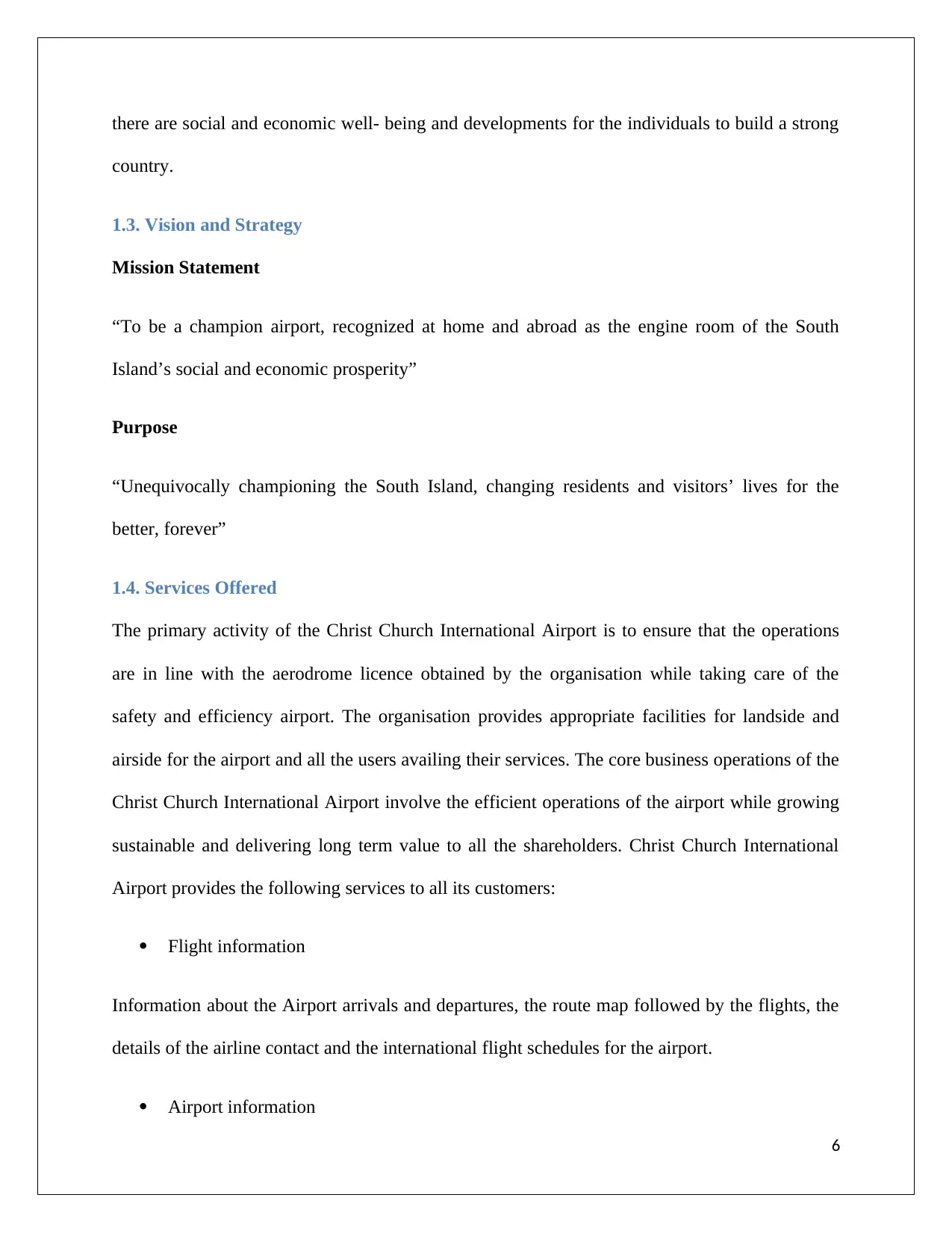
there are social and economic well- being and developments for the individuals to build a strong
country.
1.3. Vision and Strategy
Mission Statement
“To be a champion airport, recognized at home and abroad as the engine room of the South
Island’s social and economic prosperity”
Purpose
“Unequivocally championing the South Island, changing residents and visitors’ lives for the
better, forever”
1.4. Services Offered
The primary activity of the Christ Church International Airport is to ensure that the operations
are in line with the aerodrome licence obtained by the organisation while taking care of the
safety and efficiency airport. The organisation provides appropriate facilities for landside and
airside for the airport and all the users availing their services. The core business operations of the
Christ Church International Airport involve the efficient operations of the airport while growing
sustainable and delivering long term value to all the shareholders. Christ Church International
Airport provides the following services to all its customers:
Flight information
Information about the Airport arrivals and departures, the route map followed by the flights, the
details of the airline contact and the international flight schedules for the airport.
Airport information
6
country.
1.3. Vision and Strategy
Mission Statement
“To be a champion airport, recognized at home and abroad as the engine room of the South
Island’s social and economic prosperity”
Purpose
“Unequivocally championing the South Island, changing residents and visitors’ lives for the
better, forever”
1.4. Services Offered
The primary activity of the Christ Church International Airport is to ensure that the operations
are in line with the aerodrome licence obtained by the organisation while taking care of the
safety and efficiency airport. The organisation provides appropriate facilities for landside and
airside for the airport and all the users availing their services. The core business operations of the
Christ Church International Airport involve the efficient operations of the airport while growing
sustainable and delivering long term value to all the shareholders. Christ Church International
Airport provides the following services to all its customers:
Flight information
Information about the Airport arrivals and departures, the route map followed by the flights, the
details of the airline contact and the international flight schedules for the airport.
Airport information
6
Paraphrase This Document
Need a fresh take? Get an instant paraphrase of this document with our AI Paraphraser
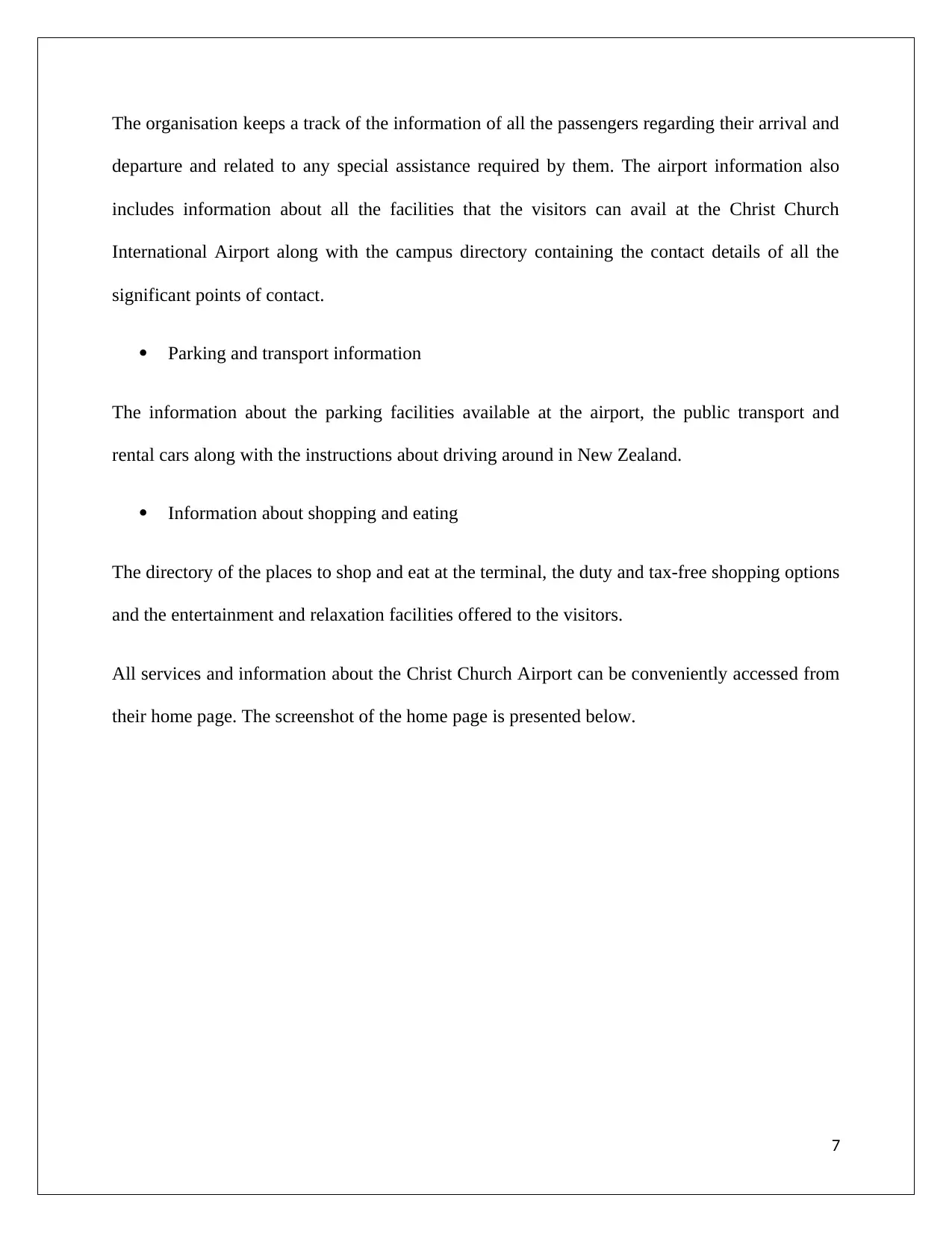
The organisation keeps a track of the information of all the passengers regarding their arrival and
departure and related to any special assistance required by them. The airport information also
includes information about all the facilities that the visitors can avail at the Christ Church
International Airport along with the campus directory containing the contact details of all the
significant points of contact.
Parking and transport information
The information about the parking facilities available at the airport, the public transport and
rental cars along with the instructions about driving around in New Zealand.
Information about shopping and eating
The directory of the places to shop and eat at the terminal, the duty and tax-free shopping options
and the entertainment and relaxation facilities offered to the visitors.
All services and information about the Christ Church Airport can be conveniently accessed from
their home page. The screenshot of the home page is presented below.
7
departure and related to any special assistance required by them. The airport information also
includes information about all the facilities that the visitors can avail at the Christ Church
International Airport along with the campus directory containing the contact details of all the
significant points of contact.
Parking and transport information
The information about the parking facilities available at the airport, the public transport and
rental cars along with the instructions about driving around in New Zealand.
Information about shopping and eating
The directory of the places to shop and eat at the terminal, the duty and tax-free shopping options
and the entertainment and relaxation facilities offered to the visitors.
All services and information about the Christ Church Airport can be conveniently accessed from
their home page. The screenshot of the home page is presented below.
7
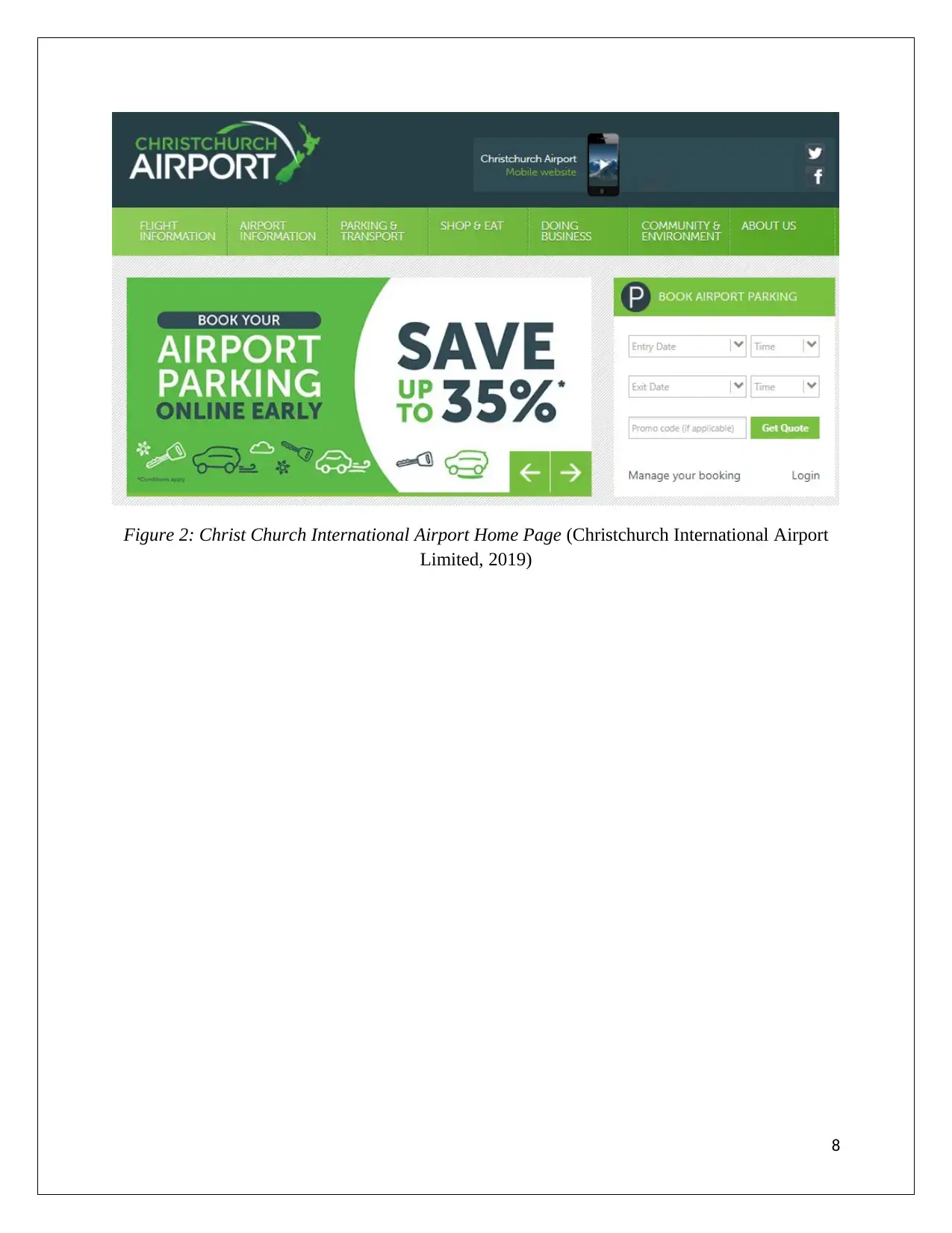
Figure 2: Christ Church International Airport Home Page (Christchurch International Airport
Limited, 2019)
8
Limited, 2019)
8
⊘ This is a preview!⊘
Do you want full access?
Subscribe today to unlock all pages.

Trusted by 1+ million students worldwide
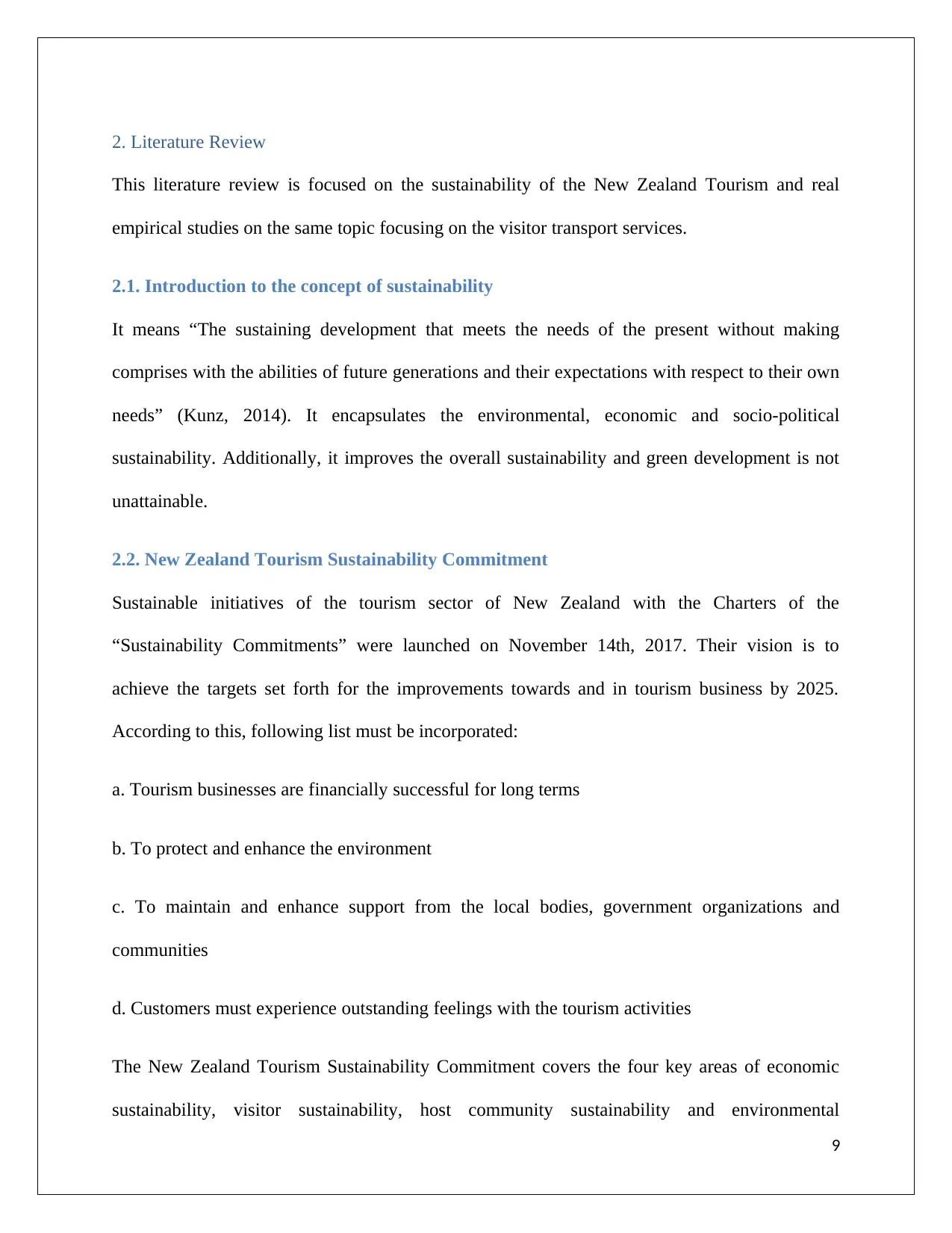
2. Literature Review
This literature review is focused on the sustainability of the New Zealand Tourism and real
empirical studies on the same topic focusing on the visitor transport services.
2.1. Introduction to the concept of sustainability
It means “The sustaining development that meets the needs of the present without making
comprises with the abilities of future generations and their expectations with respect to their own
needs” (Kunz, 2014). It encapsulates the environmental, economic and socio-political
sustainability. Additionally, it improves the overall sustainability and green development is not
unattainable.
2.2. New Zealand Tourism Sustainability Commitment
Sustainable initiatives of the tourism sector of New Zealand with the Charters of the
“Sustainability Commitments” were launched on November 14th, 2017. Their vision is to
achieve the targets set forth for the improvements towards and in tourism business by 2025.
According to this, following list must be incorporated:
a. Tourism businesses are financially successful for long terms
b. To protect and enhance the environment
c. To maintain and enhance support from the local bodies, government organizations and
communities
d. Customers must experience outstanding feelings with the tourism activities
The New Zealand Tourism Sustainability Commitment covers the four key areas of economic
sustainability, visitor sustainability, host community sustainability and environmental
9
This literature review is focused on the sustainability of the New Zealand Tourism and real
empirical studies on the same topic focusing on the visitor transport services.
2.1. Introduction to the concept of sustainability
It means “The sustaining development that meets the needs of the present without making
comprises with the abilities of future generations and their expectations with respect to their own
needs” (Kunz, 2014). It encapsulates the environmental, economic and socio-political
sustainability. Additionally, it improves the overall sustainability and green development is not
unattainable.
2.2. New Zealand Tourism Sustainability Commitment
Sustainable initiatives of the tourism sector of New Zealand with the Charters of the
“Sustainability Commitments” were launched on November 14th, 2017. Their vision is to
achieve the targets set forth for the improvements towards and in tourism business by 2025.
According to this, following list must be incorporated:
a. Tourism businesses are financially successful for long terms
b. To protect and enhance the environment
c. To maintain and enhance support from the local bodies, government organizations and
communities
d. Customers must experience outstanding feelings with the tourism activities
The New Zealand Tourism Sustainability Commitment covers the four key areas of economic
sustainability, visitor sustainability, host community sustainability and environmental
9
Paraphrase This Document
Need a fresh take? Get an instant paraphrase of this document with our AI Paraphraser
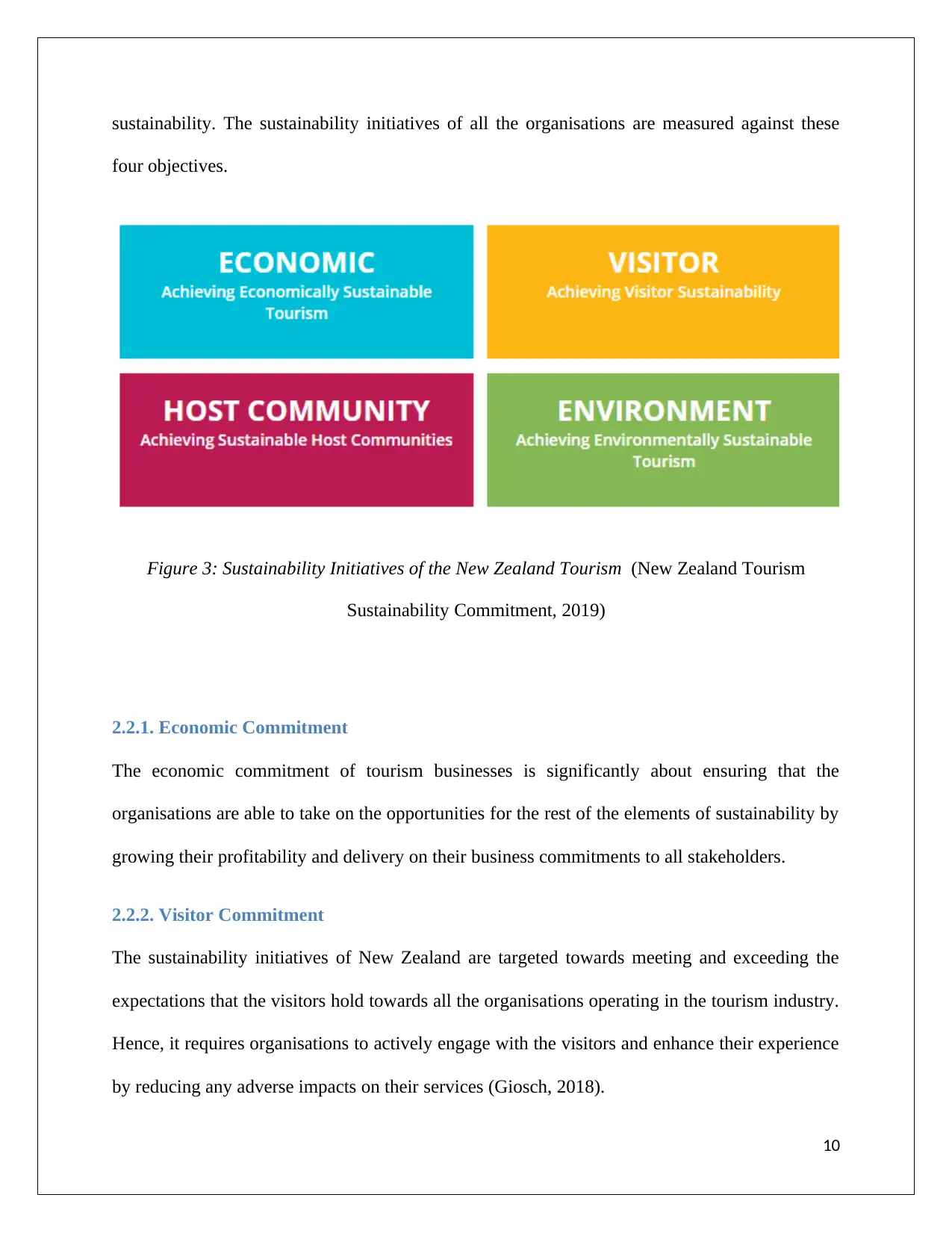
sustainability. The sustainability initiatives of all the organisations are measured against these
four objectives.
Figure 3: Sustainability Initiatives of the New Zealand Tourism (New Zealand Tourism
Sustainability Commitment, 2019)
2.2.1. Economic Commitment
The economic commitment of tourism businesses is significantly about ensuring that the
organisations are able to take on the opportunities for the rest of the elements of sustainability by
growing their profitability and delivery on their business commitments to all stakeholders.
2.2.2. Visitor Commitment
The sustainability initiatives of New Zealand are targeted towards meeting and exceeding the
expectations that the visitors hold towards all the organisations operating in the tourism industry.
Hence, it requires organisations to actively engage with the visitors and enhance their experience
by reducing any adverse impacts on their services (Giosch, 2018).
10
four objectives.
Figure 3: Sustainability Initiatives of the New Zealand Tourism (New Zealand Tourism
Sustainability Commitment, 2019)
2.2.1. Economic Commitment
The economic commitment of tourism businesses is significantly about ensuring that the
organisations are able to take on the opportunities for the rest of the elements of sustainability by
growing their profitability and delivery on their business commitments to all stakeholders.
2.2.2. Visitor Commitment
The sustainability initiatives of New Zealand are targeted towards meeting and exceeding the
expectations that the visitors hold towards all the organisations operating in the tourism industry.
Hence, it requires organisations to actively engage with the visitors and enhance their experience
by reducing any adverse impacts on their services (Giosch, 2018).
10
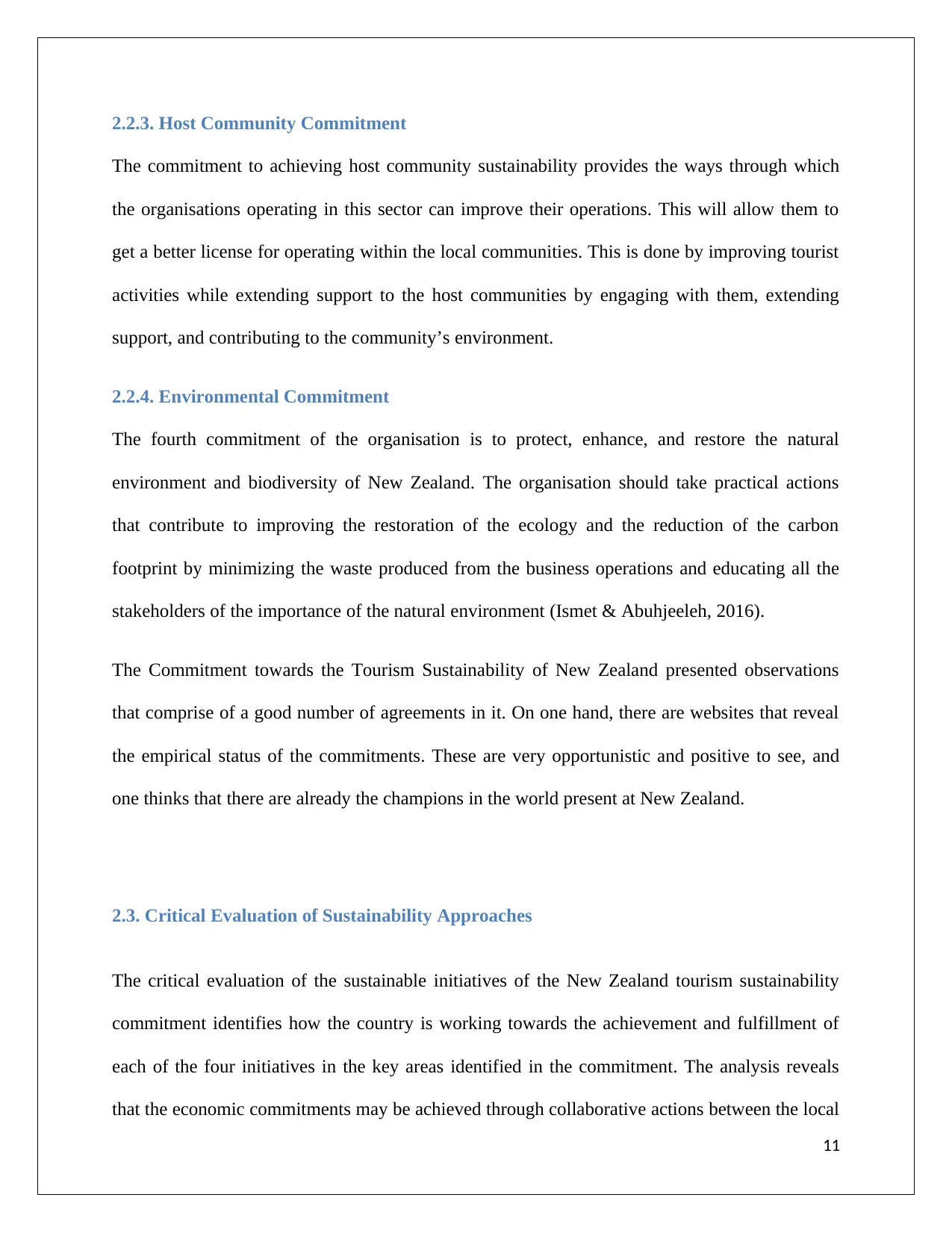
2.2.3. Host Community Commitment
The commitment to achieving host community sustainability provides the ways through which
the organisations operating in this sector can improve their operations. This will allow them to
get a better license for operating within the local communities. This is done by improving tourist
activities while extending support to the host communities by engaging with them, extending
support, and contributing to the community’s environment.
2.2.4. Environmental Commitment
The fourth commitment of the organisation is to protect, enhance, and restore the natural
environment and biodiversity of New Zealand. The organisation should take practical actions
that contribute to improving the restoration of the ecology and the reduction of the carbon
footprint by minimizing the waste produced from the business operations and educating all the
stakeholders of the importance of the natural environment (Ismet & Abuhjeeleh, 2016).
The Commitment towards the Tourism Sustainability of New Zealand presented observations
that comprise of a good number of agreements in it. On one hand, there are websites that reveal
the empirical status of the commitments. These are very opportunistic and positive to see, and
one thinks that there are already the champions in the world present at New Zealand.
2.3. Critical Evaluation of Sustainability Approaches
The critical evaluation of the sustainable initiatives of the New Zealand tourism sustainability
commitment identifies how the country is working towards the achievement and fulfillment of
each of the four initiatives in the key areas identified in the commitment. The analysis reveals
that the economic commitments may be achieved through collaborative actions between the local
11
The commitment to achieving host community sustainability provides the ways through which
the organisations operating in this sector can improve their operations. This will allow them to
get a better license for operating within the local communities. This is done by improving tourist
activities while extending support to the host communities by engaging with them, extending
support, and contributing to the community’s environment.
2.2.4. Environmental Commitment
The fourth commitment of the organisation is to protect, enhance, and restore the natural
environment and biodiversity of New Zealand. The organisation should take practical actions
that contribute to improving the restoration of the ecology and the reduction of the carbon
footprint by minimizing the waste produced from the business operations and educating all the
stakeholders of the importance of the natural environment (Ismet & Abuhjeeleh, 2016).
The Commitment towards the Tourism Sustainability of New Zealand presented observations
that comprise of a good number of agreements in it. On one hand, there are websites that reveal
the empirical status of the commitments. These are very opportunistic and positive to see, and
one thinks that there are already the champions in the world present at New Zealand.
2.3. Critical Evaluation of Sustainability Approaches
The critical evaluation of the sustainable initiatives of the New Zealand tourism sustainability
commitment identifies how the country is working towards the achievement and fulfillment of
each of the four initiatives in the key areas identified in the commitment. The analysis reveals
that the economic commitments may be achieved through collaborative actions between the local
11
⊘ This is a preview!⊘
Do you want full access?
Subscribe today to unlock all pages.

Trusted by 1+ million students worldwide
1 out of 26
Related Documents
Your All-in-One AI-Powered Toolkit for Academic Success.
+13062052269
info@desklib.com
Available 24*7 on WhatsApp / Email
![[object Object]](/_next/static/media/star-bottom.7253800d.svg)
Unlock your academic potential
Copyright © 2020–2025 A2Z Services. All Rights Reserved. Developed and managed by ZUCOL.





